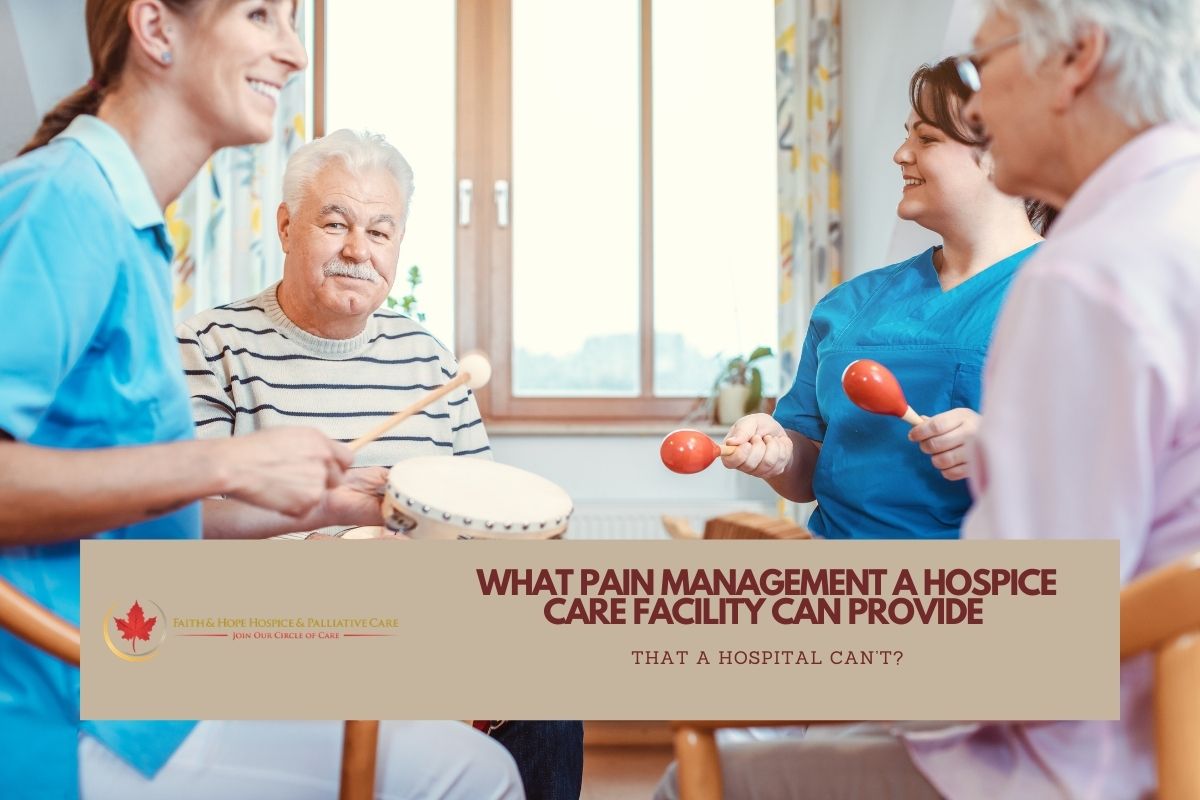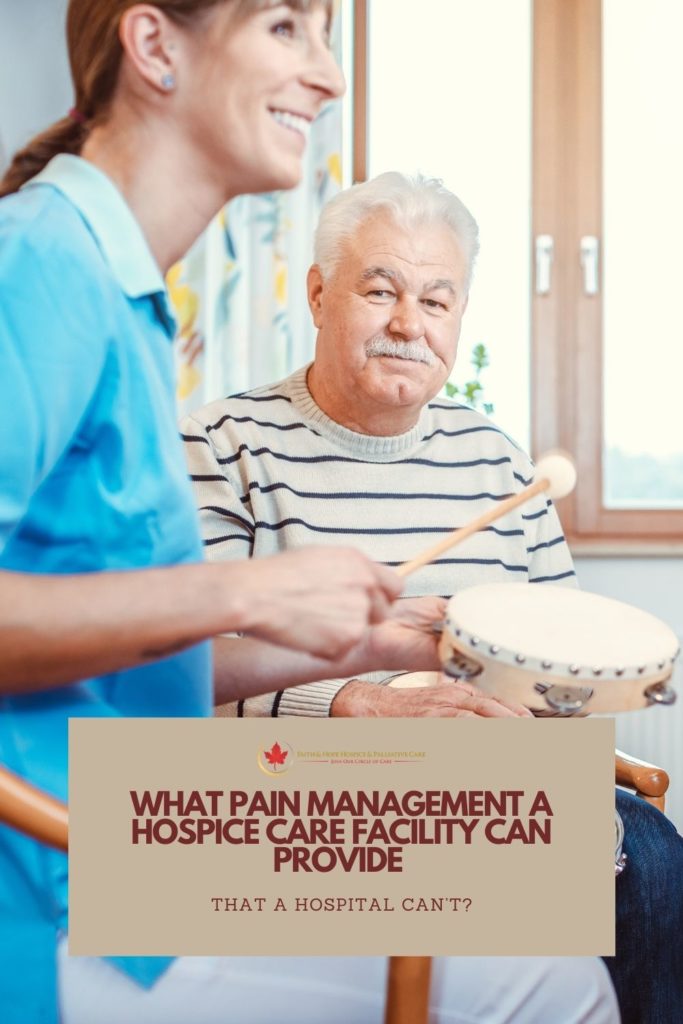
- By: administrator
- Blog
- No Comments
Patients who are suffering from a terminal illness often experience significant pain. Although this is thought to be a normal part of the disease process, there is no need for patients to suffer. Fortunately, modern medicine and healthcare has a stretch of effective pain relief options that can allow individuals who are getting closer to end of life be more comfortable through hospice services.

Hospice’s Pain Management Philosophy
Hospice concentrates on specialized care and comfort so patients can control their pain and other symptoms that they are experiencing towards the end of their life.
One of the main principles is that no patient should pass away in pain. Holistic approaches are utilized to reduce an individual’s physical, emotional and spiritual suffering.
To be qualified for hospice, patients must have been certified of a diagnosis of six months or less to live so long as their terminal illness takes its normal course. A hospice provider can be a very important resource for these patients and their families since it provides a more comprehensive form of care compared to hospitals.
Signs and Symptoms of Pain
Although many patients can let you know about their pain levels, other patients can sometimes believe that letting you know about their pain will make them look weak – which is not the case. In other instances, Alzheimer’s and other dementia-related diseases make it challenging for patients to communicate their needs. Whatever it may be, caregivers should look out for signs and symptoms that show their loved one is in pain.
Some signs to look for include the following:
- Increased breathing rate
- Tightly closed eyes or rapid blinking
- An increase in the patient’s systolic blood pressure from their baseline
- Holding arm or leg muscles tightly or a rigid body posture
- Rocking, fidgeting, or pacing
- Not wanting care or guarding certain areas of the body when turning
- Becoming withdrawn
- Getting more aggressive or easily angered
- Crying
- Increased confusion
- Vocalizations such as moaning, calling out, sighing, and asking for help
The Differences Between A Hospice And A Hospital
Generally, a hospital focuses on curing people and treating their illness, which is normally not an option for patients with end-stage disease. A hospice is more beneficial for those with an incurable disease because their focus is more on comfort care which can provide them with more dignity and compassion during their final days.
Despite the fact that hospitals are fully equipped to provide people with medication, antibiotics, fluid, and bed rest, their main objective is to combat illness.
On the other side of the coin, hospices offer an extensive range of pain management and emotional support services. One visible feature that sets them apart from hospitals is the likelihood of non-medical approaches to treating pain. Listed below are some of the non-pharmacological pain management approaches used by hospices that are not usually found in hospitals.
Massage
Massage is usually offered as part of hospice care to ease pain and anxiety in patients, with some hospices engaging the help of volunteer massage therapists.
Based on research from a 2008 study in the Annals of Internal Medicine, advanced cancer patients who were experiencing moderate to severe pain felt a significant improvement in pain relief as well as emotional and physical distress after two weeks of massage therapy or simple touch therapy.
Music Therapy
Music therapy is an effective tool that many hospices use to help patients physically, spiritually, and emotionally. Studies have shown that music therapy not only alleviates pain and anxiety but also encourages relaxation and support, which is an essential part of the end-of-life process for many patients.
Music therapy is specifically advantageous to patients whose pain and symptoms are challenging to control with traditional medical interventions and those who feel anxious or have dementia.
Acupuncture
Acupuncture is an ancient technique that originates from China. It can help tackle many types of pain in terminally ill patients. It consists of inserting very fine needles into a patient’s skin at particular acupoints that are thought to assist pain relief by releasing endorphins, affecting the part of the brain governing chemicals that control mood.
The needles are usually left in place for 10 to 30 minutes and may also be manipulated with mild heat or electrical stimulation to improve the impact.
Animal Therapy
Owning a pet has proven to provide various health benefits, and pet interaction is also helpful for terminally ill patients. Studies have revealed that patients who interacted with dogs enjoyed a significant reduction in pain.
When patients have visits with therapy dogs it can reduce stress hormones, increase the levels of the body’s natural opiates known as endorphins, and increase levels of oxytocin, a hormone that can alter a person’s pain experience and response to stress. Plus, animal therapy can improve mood, which can also help with pain relief.
Cold Or Hot Compresses
If a patient is experiencing concentrated pain in a specific location, they could benefit from cold or hot compresses. The individualized care that hospices provide allows carers to offer patients with tailored solutions to the causes of their pain that can be modified as their pain changes because of the regular one-on-one interactions between patients and their assigned caregivers.
Talk Therapy
Physical and emotional pain has a strong connection between them, and addressing problems such as depression and anxiety that people normally face when approaching their end of life can do a lot of good when improving physical pain as well.
Additionally, a hospice is a better option for a person who is going through the end-of-life process because they usually provide patients with volunteers to talk through their end-of-life issues and chaplains for spiritual support.
It is important to note that both hospices and hospitals offer patients pain medications that vary from mild analgesics such as aspirin and ibuprofen to strong opiates such as morphine to take care of different levels of pain.
Nonetheless, hospices have the upper hand when it comes to addressing pain with alternative techniques for a more overall approach.
